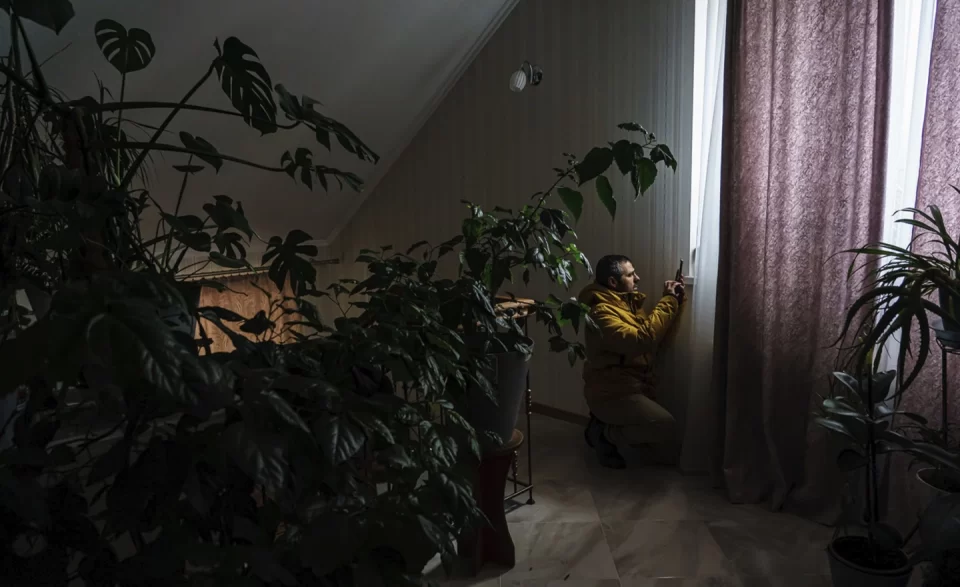In U.S., Debate Continues on Coverage Priorities
Seattle Times Revisits WWII Internment Coverage
In Poll, Most Back Smith Over Rock on ‘The Slap,’ but now Academy says Smith broke its rules, faces consequences
Anti-Lynching Law Took 124 Years
Homepage photo: Hiding in a home in Irpin, Ukraine. (Credit: Marcus Yam/Los Angeles Times)
Support Journal-isms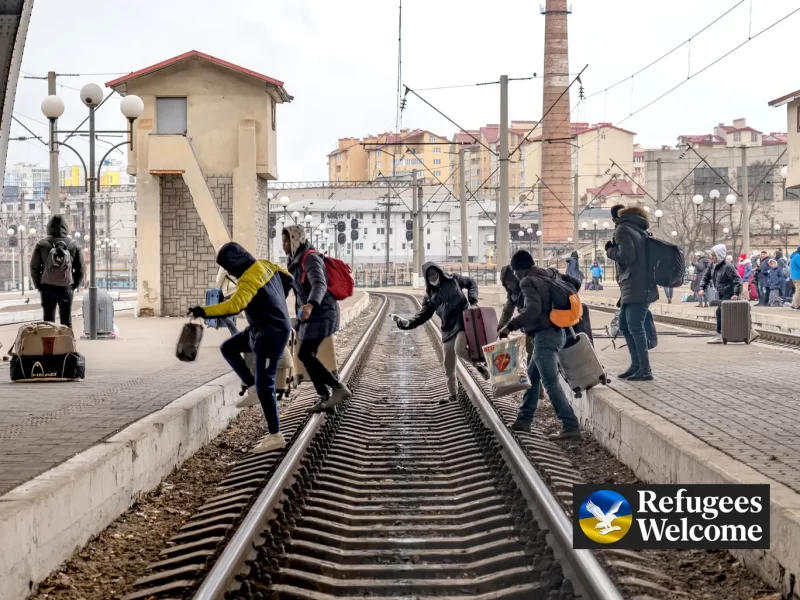
In U.S., Debate Continues on Coverage Priorities
“Non-white students who have fled Ukraine have been detained by [European Union] border authorities in what has been condemned as ‘clearly discriminatory’ and ‘not acceptable‘,” May Bulman and Nadine White reported for Britain’s The Independent.
“An investigation by The Independent, in partnership with Lighthouse Reports and other media partners, reveals that Ukraine residents of African origin who have crossed the border to escape the war have been placed in closed facilities, with some having been there for weeks.
“At least four students who have fled Vladimir Putin’s invasion are being held in a long-term holding facility Lesznowola, a village 40km from the Polish capital Warsaw, with little means of communication with the outside world and no legal advice.
“One of the students said they were stopped by officials as they crossed the border and were given ‘no choice’ but to sign a document they did not understand before they were then taken to the camp. They do not know how long they will be held there.
“A Nigerian man currently detained said he was ‘scared’ about what will happen to him after being held in the facility for more than three weeks. . . .”
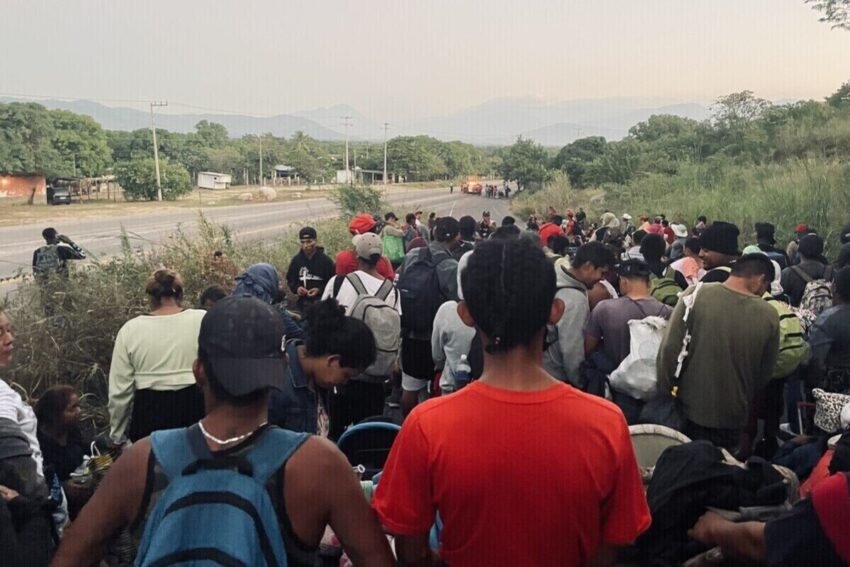
The March 24 report by the Independent and its media partners is part of a continuing racial narrative that questions the completeness of the reporting on the Russian invasion of Ukraine and the context in which it is taking place. The invasion is having ripple effects around the globe, affecting food prices in North Africa and the Middle East, the price of a college education for students in India and politics in Latin America.
News editors determine which angles to pursue and where to deploy resources. Much depends on media accessibility to the location in question, but that is not the only factor.
Brazilian journalist Yan Boechat, who was in Ukraine, told Gabriel Bonis of LatAm Journalism Review that Ukraine receives more international prominence because it takes place in Europe and it affects European civilians. “I was in the Ethiopian war, where a lot of people died, but nobody wanted to know about that conflict,” he said.
Here in the United States, veteran journalist Maria Hinojosa, who traveled with Haitian refugees seeking asylum as they made their way through Latin America, only to be detained for months by the United States, contrasted their experience with the open-arms U.S. welcome for Ukrainian refugees. She was joined Wednesday on “Democracy Now!” by Guerline Jozef, an advocate for Haitian refugees. “We are ready and willing to welcome immigrants as long as they are not Black and brown,” Jozef said.
Hinojosa also criticized media demonization of caravans joined by those seeking safety in the United States. “It is a caravan of love, of solidarity,” she said. “The caravan is the only place you feel safe.”
Jon Allsop wrote March 15 in Columbia Journalism Review, “The biases that are often present in Western coverage of war and the biases that are making the coverage of this war different both ultimately reflect ingrained assumptions about global power dynamics that are not only morally indefensible, but factually untenable. . . .”
Washington Post columnist Eugene Robinson, a former foreign editor at the newspaper, wrote March 14, “I have to wonder whether something more than technology is involved in the way this war, as opposed to other wars, is being presented. The unmistakable subtext of the coverage is: These are people just like us, and we could be at risk like them. . . . Whether intentionally or subconsciously, news organizations make this war more vivid and more tragic by focusing so tightly on victims and refugees. We get to see them as individuals, not as an undifferentiated mass. . . .”
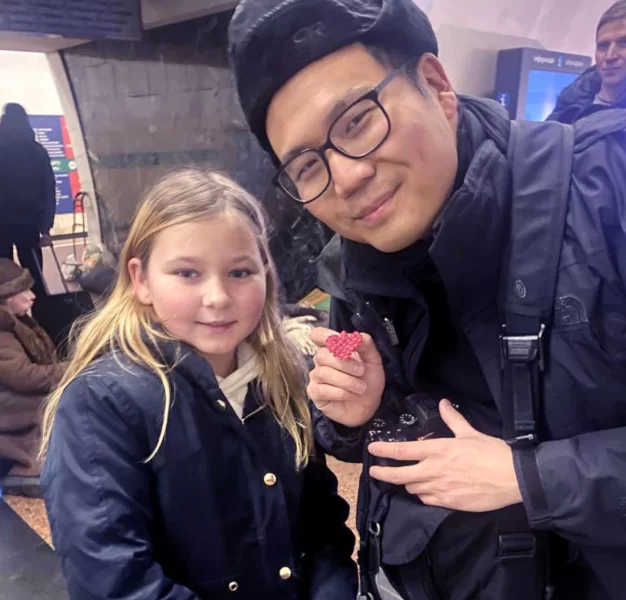
Tony Norman, a columnist at the Pittsburgh Post-Gazette, and president of the National Society of Newspaper Columnists, wrote March 22 under the headline, “Barbarians inside and outside the gates of Ukraine; President [Volodymyr] Zelenskyy hasn’t spoken out against bigotry experienced by Black Ukrainians and African students in his country.” Journalists Robinson and Norman are Black.
Karolina Ashion, a Black Ukrainian television presenter and producer, shared last summer “what she describes as the most painful moment of her career: when her former boss — then the director of Ukraine’s 1+1 media conglomerate and current Minister of Culture Alexander Tkachenko — allegedly told her that her appearance on a popular morning show would hurt the network’s ratings,” as the Daily Beast reported.
And yet, Black people who are in Ukraine, including the few Black journalists, are as fervent as anyone in urging support for the country in its time of peril.
American freelancer Terrell Jermaine Starr tweeted March 20, “@MalcolmNance and I understand the violence [Russian President Vladimir] Putin wages against Ukraine better than most westerners because, as Black people, we get oppression. Leading up to the invasion, he described Ukrainians in very racist ways. Listen to our interview on
@gaslitnation for our analysis.”
Kimberly St. Julian-Varnon. a University of Pennsylvania history expert who is Black, has been helping a group of stranded international students in Sumy, Ukraine, near the Russian border, which has been heavily bombarded since the invasion started.
She told Jenice Armstrong of the Philadelphia Inquirer, “If Ukraine falls to Russia, what do you think will happen to these Black and brown people? They are going to be killed. They are visible minorities. I’m in contact with a couple of students from Sumy State University … [They] were trying to leave [and] got shot at. They sent me pictures of bullet holes in their luggage. So, this is very real. If Russia is widely killing Slavic-looking Ukrainian citizens, what do you think they will do to very visible minorities?”
Still, some, while sharing condemnation for the invasion, also embrace “what about — ” theories that the United States shares the blame, even though others counter some of their arguments.
One contention is that the United States and NATO pushed Russia to its position by its eastward expansion closer to Russia’s borders. But Timothy Snyder, a Yale historian who spoke on “Democracy Now!, responded March 1, “when we speak of NATO enlargement, I mean, that’s a bit of a misnomer. NATO was not there to enlarge. There wasn’t much willingness on the part of Western Europe or the U.S. to enlarge. It was the East Europeans themselves who pushed the process forward.”
Another barb is that the NATO expansion was a provocation comparable to the Cuban missile crisis of October 1962, when the Soviet Union installed missiles 90 miles from the United States.
“Ukraine posed no threat to Russia, much less an imminent threat. There are no NATO nukes in Ukraine aimed at Moscow, so the Cuban Missile Crisis, in 1962, is a weak parallel,” Tom Piatak, contributing editor to Chronicles: A Magazine of American Culture, wrote Tuesday.
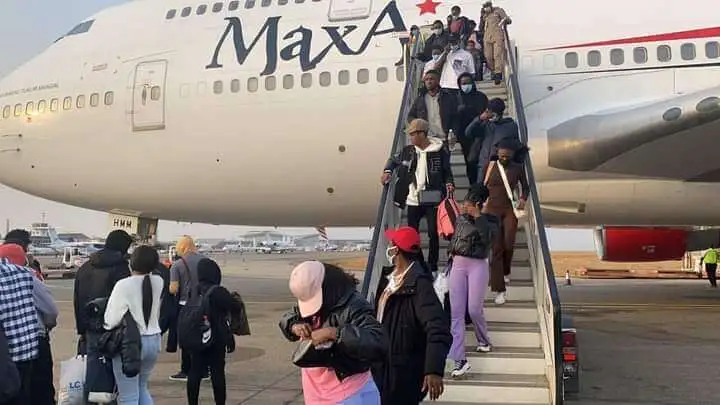
A third assertion is that the United States is doing in Yemen what the Russians are in Ukraine, but the media are playing insufficient attention. Shireen Al-Adeimi, an assistant professor of education at Michigan State University who has worked for years to raise awareness on Yemen and human rights, told Janine Jackson of Fairness & Accuracy In Reporting, “the fact of the matter is that the US is really a party to the war [in Yemen], and they don’t want to end this war because they are a party to the war. They’re engaged in hostilities. And yet they’ve enjoyed this PR campaign, essentially, of it being called ‘the Saudi-led coalition’ and not ‘the US-led war in Yemen.’ ”
The Yemen crisis is indeed devastating, and few would argue that it is receiving the coverage it merits. The United Nations has described Yemen as the world’s largest humanitarian catastrophe.
More than a dozen U.N. agencies and international aid groups said this month that 161,000 people in Yemen are likely to experience famine over the second half of 2022 — a fivefold increase from the current figure.
Moreover, the crisis is likely to deteriorate because of the war in Ukraine. Yemen depends almost entirely on food imports, with 30 percent of its wheat imports coming from Ukraine, the U.N. agencies said, according to the Associated Press.
Critics such as The Intercept have run headlines such as “AS U.S. FOCUSES ON UKRAINE, YEMEN STARVES,” portraying the Ukraine and Yemen crises as equivalent, though the Ukraine situation involves a nuclear power and has global consequences.
” That’s a big worry,” Allsop conceded in Columbia Journalism Review. “But it doesn’t explain why coverage focused on Ukrainian suffering — which has been rightly prominent, and often excellent — has dwarfed the attention the media collectively pays to human suffering in other warzones. As Moky Makura of Africa No Filter, a group that works to dispel stereotypes about the continent, wrote for CNN recently, ‘The ‘unthinkable things’ that happen in places like Africa are typically reported in terms of issues, numbers and trends — rather than the people, the emotions and the lives destroyed. . . .”
“In the broadest sense, mainstream Western media has been pretty united in denouncing Russia’s invasion — a far cry, it would seem, from the bellicose punditry and credulous reporting that legitimized the US invasion of Iraq, for example. But old modes of war coverage can manifest in subtler ways, too. . . .”
James Jeffrey added last week in the Progressive, “Recognizing such double standards in the media — whether steeped in implicit or subconscious racism or not — is crucial if we are to better nourish our empathy and abilities to parse the war in Ukraine and in conflicts occurring elsewhere.”
- Jon Allsop, Columbia Journalism Review: The biases in coverage of the war in Ukraine (March 15)
- Shuaib Almosawa, the Intercept: As U.S. Focuses on Ukraine, Yemen Starves (March 16)
- Jenice Armstrong, Philadelphia Inquirer: Don’t let reports of racist acts by Ukrainians against Africans distract from what’s at stake (March 7)
- Associated Press: AP Photos: 1 Month: War in Ukraine rages on; 3M have fled (March 23)
- Perry Bacon Jr., Washington Post: Biden should defend U.S. democracy as aggressively as he is defending Ukraine (March 23)
- Wayne Bennett, the Field Negro: Another World War? (March 6)
- Kevin B. Blackistone, Washington Post: When war and violence reign, sports are no longer an escape (March 20)
- Charles M. Blow, New York Times: What Is Our Moral Obligation in Ukraine? (March 16)
- Gabriel Bonis, LatAm Journalism Review: Three South American journalists covering the war in Ukraine (March 23)
- Jamelle Bouie, New York Times: On Ukraine, I Know What I Don’t Know (March 5)
- Robert Burns, Associated Press: Putin put Russia’s nuclear forces on alert. What does that mean for the risk of nuclear war? (Feb. 27, updated Feb. 28)
- Carib News, New York: Jamaicans among human rights attorneys appealing to UN on behalf of Black refugees in Ukraine and Poland (March 17)
- Karen Juanita Carrillo, New York Amsterdam News: Black coalitions created for #AfricansInUkraine
- Donovan Dooley, News One: Hampton University’s Free Tuition Offer To Ukraine Students Draws Attention To Debt Crisis At HBCUs
- John Eggerton, Nexttv.com: UNESCO Helps Protect Ukraine Journalists, Relocate Unions (March 18)
- Jon Gambrell, Associated Press: As Ukraine grabs headlines, keep Yemen in mind, Red Cross official asks
- Laurin-Whitney Gottbrath, Axios: UN leaders urge the world to not forget about other global crises
- Renée Graham, Boston Globe: Graphic photos are defining the war in Ukraine. Would similar images reignite America’s gun reform efforts? (March 22)
- LZ Granderson, Los Angeles Times: Our divided U.S. should be able to unite for Ukraine (March 17)
- Bryce Greene, Fairness & Accuracy In Reporting: What You Should Really Know About Ukraine (Jan. 28)
- Leonard Greene, Daily News, New York: Free Brittney Griner: WNBA star remains a prisoner of war in Russia (March 20)
- Emil Guillermo, Asian American Legal Defense and Education Fund: On watching Zelensky’s speech on a day that lives in infamy for Asian Americans (March 16)
- Tanu Henry, California Black Media: California Black Clergy, Political Leaders Condemn Racism in Ukraine
- Julie Hollar, Fairness & Accuracy In Reporting: How Much Less Newsworthy Are Civilians in Other Conflicts? (March 18)
- Caleb Howe, Mediaite: MSNBC’s Velshi Suggests Nations Are Welcoming Ukrainian Refugees ‘Because They’re White and Christians’
- Human Rights Watch: Ukraine: Ensure Safe Passage, Aid for Mariupol Civilians (March 21)
- Human Rights Watch: Russia’s Invasion of Ukraine Exacerbates Hunger in Middle East, North Africa (March 21)
- Murtaza Hussain, The Intercept: Not One Bloc or the Other: Ukraine War Shows Emerging Post-American World
- Janine Jackson, Fairness & Accuracy In Reporting: ‘Just Pay Attention to What Our Own Government Is Doing in Yemen’– CounterSpin interview with Shireen Al-Adeimi on Yemen
- Ben Jealous, People for the American Way: Black Americans and the Worldwide Principles of Democracy (March 23)
- Solomon Jones, Philadelphia Inquirer: The mistreatment of Black students trying to flee Ukraine is a reminder of racism’s reach (March 2)
- Samy Magdy, Associated Press: ‘Harrowing figures’: Yemen report says 161,000 likely to face famine (March 14)
- Samy Magdy, Associated Press: U.N. raises $1.3 billion for Yemen, less than a third requested, in effort shadowed by Ukraine war (March 16)
- Pablo Manríquez, Latino Rebels: Ukrainian Refugees Spotlight Restrictionist Policies Toward Black and Brown Immigrants
- Native America Calling: The continuing Russian influence in Alaska (March 16)
- Ruben Navarrette Jr., Washington Post Writers Group: Let refugees have the dignity of choosing where they live (March 24)
- Ruben Navarrette Jr., Washington Post Writers Group: The United States needs to be colorblind toward refugees (March 22)
- Tony Norman, Pittsburgh Post-Gazette: Barbarians inside and outside the gates of Ukraine — President Zelenskyy hasn’t spoken out against bigotry experienced by Black Ukrainians and African students in his country.
- Andrés Oppenheimer, Miami Herald: Latin America’s mixed message about Russia’s war in Ukraine is deplorable, and it will hurt the region (March 25)
- Clarence Page, Chicago Tribune: Ukraine’s crisis is no excuse for racism or xenophobia (March 10)
- Danielle Paquette, Washington Post: Russian mercenaries have landed in West Africa, pushing Putin’s goals as Kremlin is increasingly isolated
- Garry Pierre-Pierre, Haitian Times: US should welcome Haitian refugees as it does Ukrainians (March 21)
- Press TV, Iran: Yemen ambassador tells Press TV: Some Arab countries US tool to implement its agenda (March 20)
- Kristin Skare Orgeret and Bruce Mutsvairo, Nieman Journalism Lab: Ukraine coverage shows gender roles are changing on the battlefield and in the newsroom (March 23)
- Isha Sesay, Washington Post: African students in Ukraine have suffered. Their stories matter.
- This Day/Arise News, Nigeria: 804 Nigerians Fleeing Ukraine Evacuated, Land in Abuja (March 5)
- Declan Walsh and John Eligon, New York Times: Shunned by Others, Russia Finds Friends in Africa (March 3)
- Sarah Leah Whitson with Amy Goodman, “Democracy Now!”: A Tale of Two Wars: Biden Decries Russian Atrocities in Ukraine While Backing Saudi/UAE War in Yemen (March 16)
- Lesley Wroughton, Washington Post: Europe’s phase-out of Russian energy over the Ukraine crisis could mean opportunity for African countries (March 20)
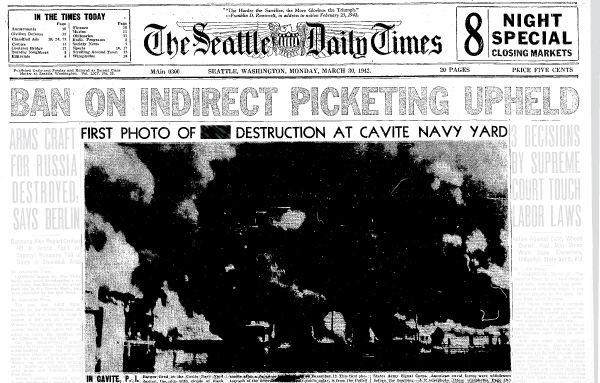
Seattle Times Revisits WWII Internment Coverage
Eighty years after Japanese-Americans were rounded up and placed in internment camps, the Seattle Times apologized for its “harmful coverage” and, Executive Editor Michele Matassa Flores wrote, “for the pain we caused in the past that still reverberates today.”
As columnist Naomi Ishisaka recalled in a separate piece, “Starting with 227 residents of Bainbridge Island on March 30, 1942, women, men and children were forced to leave their jobs, schools, homes and the lives they knew for an uncertain future. By the end, 120,000 Japanese Americans — two-thirds of them U.S. citizens — would be incarcerated in desolate camps in remote regions primarily in the Western interior during World War II.”
 Flores (pictured) wrote Sunday after a “team from our newsroom pored over the March 30, 1942, edition of The Seattle Daily Times (as we were called then), critiquing A1 (the front page) through a present-day lens of accuracy and fairness. The group included writers, editors, artists, designers, photographers, videographers, a news researcher and a digital producer.
Flores (pictured) wrote Sunday after a “team from our newsroom pored over the March 30, 1942, edition of The Seattle Daily Times (as we were called then), critiquing A1 (the front page) through a present-day lens of accuracy and fairness. The group included writers, editors, artists, designers, photographers, videographers, a news researcher and a digital producer.
“They examined pages from that critical time and consulted experts from Densho, a Japanese American history group. They also researched the work of other nearby publications and interviewed our contrite publisher, Frank Blethen, whose ancestors owned the paper then (and back to the late 1800s).
“Among other things, the team found a slur for Japanese and Japanese American people used time and again, in huge headline type, at the top of front pages and throughout the newspaper. They read reports on the arrests of ‘dangerous’ Japanese Americans, which ran with no evidence of the supposed threat. And they saw how our newspaper parroted government euphemisms like ‘humane’ and ‘efficient’ to describe the treatment of people who were ripped from their lives, homes and families. . . .”
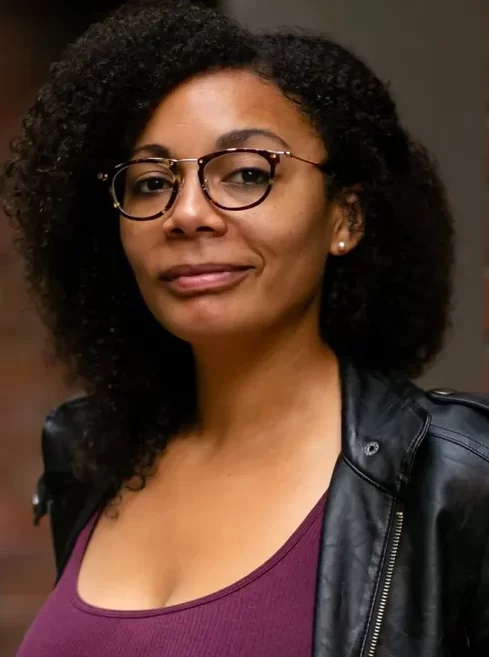 The re-examination team was led by Crystal Paul (pictured), a Black journalist and interim features editor. The paper published copies of front pages with the offensive term for Japanese Americans redacted, though those interested could click again to see the unedited version.
The re-examination team was led by Crystal Paul (pictured), a Black journalist and interim features editor. The paper published copies of front pages with the offensive term for Japanese Americans redacted, though those interested could click again to see the unedited version.
“Paul, who joined the Times in 2018, began advocating within the newsroom for this type of accountability project soon after she arrived. The reason: She was disturbed by mistakes we’d made — in both the distant and the recent past — and the resulting mistrust she encountered when reporting for us among communities of color,” Flores wrote.
Paul “recalls prospective sources side-eyeing her and she felt shame and anger as she learned of our missteps — some recent. Things like detailing the irrelevant criminal record of a shooting victim. Or repeating police accounts that obscure the truth to shift blame. Or swooping into certain neighborhoods to cover crimes or other bad news, while neglecting to write about the achievements and resilience of those areas the rest of the time.”
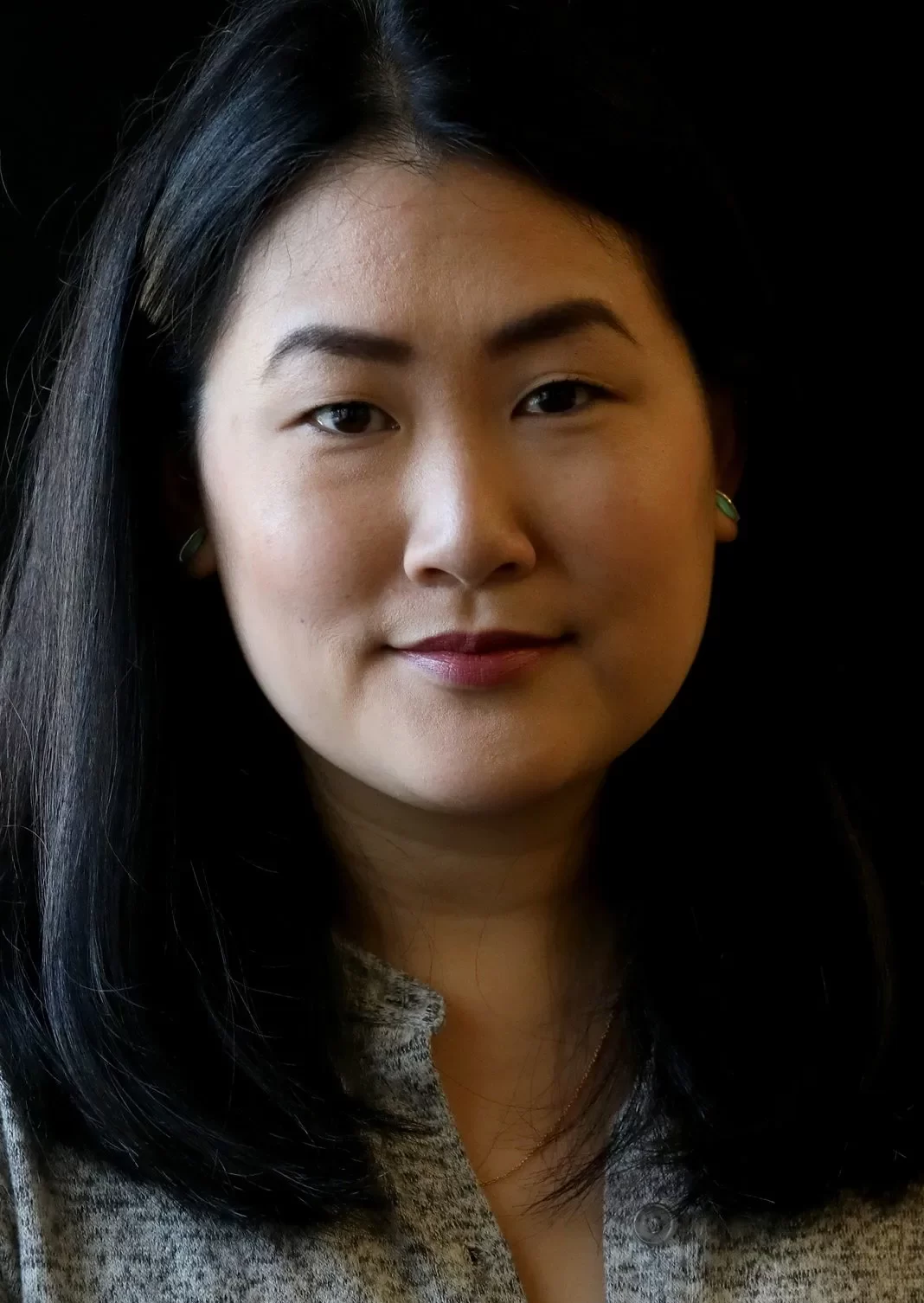 Graphics Editor Emily Eng (pictured), who is Asian American, “along with artist Jennifer Luxton and other staff members, landed on the idea of annotating the historical pages. The concept, Eng said, was to bring readers along on our thought process as we reflected and learned from past mistakes,” Flores explained.
Graphics Editor Emily Eng (pictured), who is Asian American, “along with artist Jennifer Luxton and other staff members, landed on the idea of annotating the historical pages. The concept, Eng said, was to bring readers along on our thought process as we reflected and learned from past mistakes,” Flores explained.
Flores added, “Our team is considering future installments for this project, which we have named A1 Revisited. Sadly, it won’t be hard to find other periods of coverage that cry out for examination. And not all of those will be in the distant past. We hope you, our readers, will help by pointing to past transgressions and — as always — by holding us accountable for the work we publish now.”
- Mark Van Streefkerk and Gabriel Campanario, Seattle Times: What life was like for Japanese Americans incarcerated at the Puyallup Fairgrounds
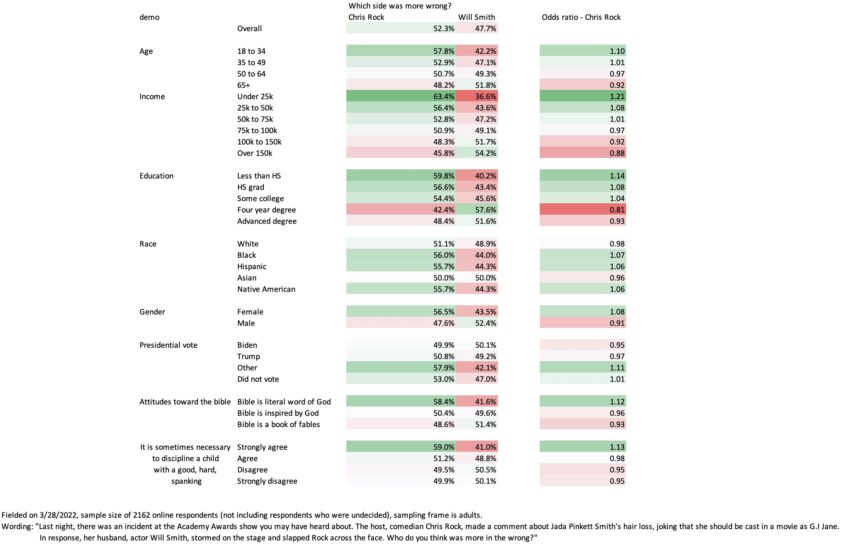
In Poll, Most Back Smith Over Rock on ‘The Slap’
- April 1 update: “Heartbroken” Will Smith Resigns From Academy Ahead Of Decision On His Future After Oscar Slap Of Chris Rock (Dominic Patten and Anthony D’Alessandro, Deadline)
Despite a seemingly overwhelming consensus among opinion writers to the contrary, “A poll conducted by Blue Rose Research, a well-known Democratic pollster, found that a higher percentage of Americans ultimately see Chris Rock in the wrong after Will Smith slapped him in the face,” Leia Idliby reported Tuesday for the New York Post.
White, Black, Hispanic and Native Americans surveyed faulted Rock, while Asian Americans were split evenly down the middle.
Women blamed Rock while 52.4 percent of men surveyed viewed Smith, who later accepted the award as “Best Actor,” in the wrong.
Smith apologized after the Academy of Motion Picture Arts and Sciences announced it would start a formal review around the Oscar night incident.
“I was out of line and I was wrong,” Smith said in the statement. “I am embarrassed and my actions were not indicative of the man I want to be.”
“The survey was conducted on Monday, the day after the much talked about Oscar ceremony, asking 2162 online respondents who they viewed as ‘more in the wrong’ during the Smith-Rock controversy,” Idiliby reported.
Meanwhile, Taryn Ryder reported for Yahoo Wednesday evening that “Will Smith may face ‘suspension’ or ‘expulsion’ from the Academy of Motion Picture Arts and Sciences for slapping Chris Rock during Sunday’s Oscars. The Board of Governors of the body that oversees the Oscars held an emergency meeting to discuss repercussions for the King Richard star, who just won his first golden statue. According to a new statement on Wednesday, the Academy asked Smith to leave the ceremony but he ‘refused.’ The organization admitted they botched the handling of the incident. . . .”
Jack Coyle wrote for the Associated Press, “A representative for the academy declined to give specifics on how it tried to removed Smith. After Smith struck Rock in response to a joke about his wife, Jada Pinkett Smith, several stars including Denzel Washington, Bradley Cooper and Tyler Perry spoke with the 53-year-old Smith. . .
“ ‘Mr. Smith’s actions at the 94th Oscars were a deeply shocking, traumatic event to witness in-person and on television,’ the academy said. ‘Mr. Rock, we apologize to you for what you experienced on our stage and thank you for your resilience in that moment. We also apologize to our nominees, guests and viewers for what transpired during what should have been a celebratory event.’ . . .”
- Kareem Abdul-Jabbar: Will Smith Did a Bad, Bad Thing: Slapping Chris Rock was also a blow to men, women, the entertainment industry, and the Black community.
- Jenice Armstrong, Philadelphia Inquirer: Don’t call Will Smith’s Oscar night assault a ‘Philly thing’
- Karen Attiah, Washington Post: When it comes to defending Black women, America is still stuck on stupid
- Justin Bariso, Inc.: Will Smith’s Apology to Chris Rock Is Only 160 Words. It’s a Master Class in Emotional Intelligence
- Eric Deggans, NPR: Should Will Smith have been allowed to collect an Oscar after he slapped Chris Rock?
- Editorial, Wall Street Journal: Will Smith Wins the Oscar for Battery
- Lulu Garcia-Navarro, Roxane Gay, Charles Blow, Esau McCaulley, New York Times: Four Opinion Writers on Will Smith’s Slap: ‘There Are No Heroes in This Story’
- LZ Granderson, Los Angeles Times: Will Smith was wrong to hit Chris Rock. But I understand
- Emil Guillermo, Asian American Legal Defense and Education Fund: Asian Americans know Will Smith’s casual violence can be deadly
- LeBron Hill, Tennessean, Nashville: Will Smith and Chris Rock can both grow from a moment of toxic masculinity
- Janet Hubert, YouTube: Janet Hubert Defends Will Smith Slapping Chris Rock: Chris Is Always Disrespecting Black Women (video)
- Earl Ofari Hutchinson, Hutchinson Report: Smith and Rock Sent a Horrible Message to the World — About Us
- Inkoo Kang, Washington Post: An unfunny, unmemorable joke changed Oscars history and Will Smith’s Hollywood story
- Brian Melley, Associated Press: Will Smith would face little more than a slap if charged
- Tiff Money, Philadelphia Inquirer: Philly comedian: Dear audience, please don’t take a cue from Will Smith
- David Moye, HuffPost: Richard Williams Has Strong Words About Will Smith Slapping Chris Rock
- Tony Norman, Pittsburgh Post-Gazette: Straight Outta West Philly
- Michele L. Norris, Washington Post: At the Oscars, the unacceptable followed the unfortunate
- Stassy Olmos, WFTS-TV, Tampa, Fla.: St. Pete native leads first all-Black production team at Oscars
- Jeneé Osterheldt, Boston Globe: Will Smith, Chris Rock, and the hypocrisy of us all
- Ernest Owens, the Grio: No, Will Smith slapping Chris Rock doesn’t set Black people back. But anti-Blackness will
- Leonard Pitts Jr., Miami Herald: If Will Smith really wanted to do the manly thing, he would have shown some restraint
- Ryan Smith, Newsweek: Will Smith’s Oscar Speech Addresses Chris Rock Spat — Read Full Transcript
- Joe Tacopino, New York Post: Unacceptable: SAG slams Will Smith’s Oscar night slap
- Touré, the Grio: Will ‘the slap’ change how we see Will Smith?
- Andrew Wallenstein, Variety: Slapgate Is Chris Rock’s Defining Moment
- Michael Paul Williams, Richmond (Va.) Times-Dispatch: The Oscars lesson: Toxic masculinity and female empowerment are a poor match
Anti-Lynching Law Took 124 Years
“Finally, 124 years after my great-grandmother Ida B. Wells first talked to President McKinley in 1898 about enacting this legislation, it happened yesterday, Michelle Duster, descendant of the crusading anti-lynching journalist, messaged.
“I come in around minute 23.”
Members of the Congressional Black Caucus were also present for President Biden’s signing of the Emmett Till Antilynching Act. It “finally designates lynching as a federal hate crime in America,” said Joyce Beatty, chairwoman of the Congressional Black Caucus. “Despite more than 200 attempts to make lynching a federal crime over the past 120 years, it has never before been done. That ends today.”
Rep. Bobby Rush, D-Ill., said, “Lynching is a longstanding and uniquely American weapon of racial terror that has for decades been used to maintain the white hierarchy. “Perpetrators of lynching got away with murder time and time again — in most cases, they were never even brought to trial.”
- Amna Nawaz, “PBS NewsHour”: Biden signs law making lynching a federal hate crime
To subscribe at no cost, please send an email to journal-isms+subscribe@groups.io and say who you are.
Facebook users: “Like” “Richard Prince’s Journal-isms” on Facebook.
Follow Richard Prince on Twitter @princeeditor
Richard Prince’s Journal-isms originates from Washington. It began in print before most of us knew what the internet was, and it would like to be referred to as a “column.” Any views expressed in the column are those of the person or organization quoted and not those of any other entity. Send tips, comments and concerns to Richard Prince at journal-isms+owner@
View previous columns (after Feb. 13, 2016).
View previous columns (before Feb. 13, 2016)
- Diversity’s Greatest Hits, 2018 (Jan. 4, 2019)
- Book Notes: Is Taking a Knee Really All That? (Dec. 20, 2018)
- Book Notes: Challenging ’45’ and Proudly Telling the Story (Dec. 18, 2018)
- Book Notes: Get Down With the Legends! (Dec. 11, 2018)
- Journalist Richard Prince w/Joe Madison (Sirius XM, April 18, 2018) (podcast)
- Richard Prince (journalist) (Wikipedia entry)
- February 2018 Podcast: Richard “Dick” Prince on the need for newsroom diversity (Gabriel Greschler, Student Press Law Center, Feb. 26, 2018)
- Diversity’s Greatest Hits, 2017 — Where Will They Take Us in the Year Ahead?
- Book Notes: Best Sellers, Uncovered Treasures, Overlooked History (Dec. 19, 2017)
- An advocate for diversity in the media is still pressing for representation, (Courtland Milloy, Washington Post, Nov. 28, 2017)
- Morgan Global Journalism Review: Journal-isms Journeys On (Aug. 31, 2017)
- Diversity’s Greatest Hits, 2016
- Book Notes: 16 Writers Dish About ‘Chelle,’ the First Lady
- Book Notes: From Coretta to Barack, and in Search of the Godfather
- Journal-isms’ Richard Prince Wants Your Ideas (FishbowlDC, Feb. 26, 2016)
- “JOURNAL-ISMS” IS LATEST TO BEAR BRUNT OF INDUSTRY’S ECONOMIC WOES (Feb. 19, 2016)
- Richard Prince with Charlayne Hunter-Gault, “PBS NewsHour,” “What stagnant diversity means for America’s newsrooms” (Dec. 15, 2015)
- Book Notes: Journalists Follow Their Passions
- Book Notes: Journalists Who Rocked Their World
- Book Notes: Hands Up! Read This!
- Book Notes: New Cosby Bio Looks Like a Best-Seller
- Journo-diversity advocate turns attention to Ezra Klein project (Erik Wemple, Washington Post, March 5, 2014)
When you shop @AmazonSmile, Amazon will make a donation to Journal-Isms Inc. https://t.co/OFkE3Gu0eK
— Richard Prince (@princeeditor) March 16, 2018

